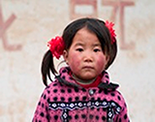On the morning of May 13, the day after the devastating earthquake shook Sichuan province, 21-year-old Chen Shichao went into labor.
The poor rural woman, who lives with her husband in the small town of Nanquan, first traveled to the nearest medical facility, Shifang Maternal & Children Health (MCH) Hospital. There she was told that her labor was complicated by a condition known as cephalopelvic disproportion, meaning her pelvis was too small to allow the birth.
Zhu Sha and her three-day-old "earthquake baby" at the Maternal and Children Health Hospital in Pengzhou, Sichuan province. Huang Yiming
But doctors at the hospital were overwhelmed treating survivors in the immediate aftermath of the earthquake. The hospital had no space or staff to spare to perform the necessary surgery.
Then Chen, along with 1,500 other people, was transferred to the 1,300-year-old local Luohan (Arhat) Temple, which had been transformed into a makeshift medical facility.
Chen's situation was so urgent that the doctors asked the abbot Suquan for permission to use a meditation room as space for immediate surgery.
The abbot granted his approval. "Some claimed that it was taboo to allow a woman to give birth in the temple," he said. "But, in my opinion, the biggest taboo for monks is to show no mercy to those in trouble."
Wang Xiaoping, a doctor with 10 years' experience working at the local hospital, said she had never encountered a labor as challenging as Chen's. Wang and her colleagues pushed together three small benches to serve as an operating table. "It was pouring with rain outside," she recalls, "and the water was leaking in through the tiles. The electricity was off, and the three nurses used flashlights so we could see."
Eight doctors assisted in the operation - twice as many as are normally required for such a procedure.
Two hours later, the successful surgery was over. Chen held in her arms a beautiful baby girl. She and her husband named their daughter Zhenwen, or Beautiful Cloud Amid the Earthquake.
Since the earthquake, more than 70 children have been born in the Buddhist temple, says Suquan.
Shifang is one of many cities in Sichuan province that have seen hospitals and other medical facilities overwhelmed in the aftermath of the quake. Statistics from the Sichuan Department of Health show that hospitals in more than 40 counties lost the ability to perform some basic functions.
"The mortality rate of children will be incredibly high this year," warns a bulletin published by the Sichuan Network of Maternal and Children Health.
In these worst-hit counties, 52 percent of the facilities were destroyed, and the immediate financial losses have been estimated at 20 million yuan ($7.40 million).
In Sichuan, the networks of mother and children hospitals, which provide check-ups and medical services to new families, also suffered great damage. For instance, several village clinics were ruined in Mianzhu county.
Before the earthquake, Sichuan had 203 hospitals for women and children, a relatively modest number in a province of 87 million people, the second most populous province in China.
According to government records, 730,000 children are born in Sichuan each year. However, the region also has alarmingly high mortality rates for both infants and pregnant women.
The maternal mortality rate is 55.4 deaths per 100,000 births, considerably higher than the national rate of 33.6 per 100,000. Sichuan's infant mortality rate is 15.5 per 100,000, slightly above the national figure of 15.3 per 100,000.
One of the reasons for the high rates is the fact that many women in the mountainous areas give birth at home, instead of going to the hospital. In addition, 70 percent of MCH hospitals lack facilities for surgery, according to the vice governor of Sichuan province, Chen Wenhua.
In light of this grim reality, Sichuan had designated 2008 the "Year for Promotion of MCH."
Before the earthquake struck, the provincial government set aside 170 million yuan to build new 103 MCH hospitals in Liangshan Yi autonomous prefecture, Ganzi Tibetan autonomous prefecture, Aba Tibetan and Qiang autonomous prefecture, as well as 130 counties.
By 2010, the goal is for 90 percent of pregnant women to give birth in hospitals, enabling the reduction of the maternal mortality rate to less than 50 per 100,000, says Han Mei, deputy director of MCH affairs, Sichuan Department of Health.
However, the earthquake disrupted the implementation of many new programs and the construction of new hospitals, Han says.
Right after the earthquake, the international community, particularly the United Nations' Children's Fund (UNICEF), did turn attention to mothers and babies in need.
UNICEF sent a package of relief materials and medicines to Sichuan. The supplies included 140 emergency health kits and nearly 64,000 packages of nutrient supplements, enough to stretch the provision of basic maternal services to 1.4 million people over a three-month period.
Yet along with relief materials, education for medical practitioners is needed. "The UNICEF assistance is welcomed, but training should also be given to the doctors and nurses, as many descriptions are written in English," observes Chen Rongjiu, vice-chairman of Shifang Red Cross Society.
Other forms of medical aid are still in great demand. Medicines and other operational and sterilizing facilities are badly needed, as much equipment was buried under the rubble. At the same time, problems created by the earthquake have intensified the demand for other medicines. For instance, the occurrence of anaemia among women and children is now higher in Sichuan than nationwide.
Psychological support for children is another focus. Wei Yingying, the Chinese representative of UNICEF, calls for more psychological care to be provided to children, whom he says are more vulnerable to post-quake trauma. A survey by UNICEF China shows that more than 5,000 children are now living apart from their relatives in quake-hit parts of Sichuan.
"Their protection should be listed as a top priority," she says.
Nationwide, the Ministry of Health is formulating a blueprint for the reconstruction of health services in Sichuan, and MCH facilities will be a major focus.
Meanwhile, the Sichuan Department of Health hopes to provide each county at least two or three obstetric tables and a modest medical building in which to perform basic operations.
Chen Shichao, the new mother, says that she never expected that she would give birth in a Buddhist temple, on a day doctors in Sichuan were racing to assist victims of a natural disaster that took 70,000 lives and left more than 18,000 missing.
(by Gong Yidong, China Features of Xinhua News Agency)




























